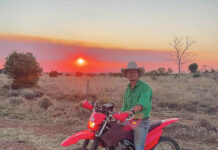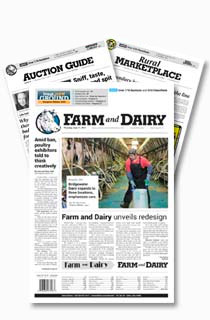
Warming spring weather brings relief from the biting cold of winter, but it also marks the start of severe weather season in Ohio, Pennsylvania and West Virginia.
At our farm, we’re used to securing the barn doors before a big thunderstorm and checking the fenceline for downed trees afterward. It floods occasionally here, and we’re no strangers to hunkering down to ride out a cold snap or a winter storm.
But I think a lot about what we would do if another natural disaster struck our farm. Just because it hasn’t happened before doesn’t mean it can’t or won’t. It feels like anything is possible these days.
Think about the communities far inland in western North Carolina that were hit hard by the remnants of Hurricane Helene last fall. Some of those same areas are now dealing with wildfires. I’m sure the farmers living in those areas never thought they’d experience two catastrophes within six months.
And as farmers with livestock, we’re not just responsible for ourselves if stuff hits the fan, but also the lives of all the animals.
Preparedness isn’t just for peace of mind and protecting what’s yours. The U.S. is one of the largest food-producing nations in the world. Livestock preparedness is critical for food security, public health, economic stability, environmental protection and community resilience, according to FEMA.
Here are some ways to prepare your farm for a natural disaster:
Assess your risk/know your hazards
Think generally about the type of things that happen where you live. Flooding and severe storm damage (wind, hail, heavy rains) are common across Ohio, Pennsylvania and West Virginia.
Tornadoes can also happen. Ohio and West Virginia both set state records for the number of tornadoes in 2024. The risk for hurricanes and wildfires is low in the tri-state area, but not zero.
If you’re not sure, FEMA has an interactive online tool that allows you to see what natural hazards your community is most at risk of: www.fema.gov/flood-maps/products-tools/national-risk-index
Now, think specifically about the risks and hazards on your farm. Are your barns or pastures in low-lying areas that are prone to flooding? Are there trees that could fall on one of your buildings, take out a fence or block a road?
If there is a wildfire, what would be your escape route? Do you have a way to evacuate all of your animals if needed? If not, do you have a way to create a defensible space to protect your animals?
Make a plan
Now that you know your situation, make a plan for each type of hazard you might face. Your flooding plan will look different than the one you use to deal with a blizzard or a wildfire.
The goal is to make all of the necessary decisions in advance so you’re prepared to handle an emergency when it happens.
Write your plan down step by step, including different options for different scenarios. If it floods, at what point will you move animals to higher ground? When are the animals safer in the barn or outside? How much time do you need to evacuate your entire farm? If you don’t have that much time, what will you do with your animals? At what point do you decide to set them loose to fend for themselves? Where will you leave food and water? How will you gather them back up afterward?
Make sure you have printed copies of your plan as well as storing it electronically. Go over the plans with farm employees or regular helpers. That way, when all hell breaks loose, you’re all on the same page. While critical thinking and problem-solving skills will come into play to help you navigate that particular situation, it’s nice to have a checklist to run through as a backup.
Prepare
Some of this stuff is going to be extra work, like trimming trees, cleaning debris from fencerows or calling your local emergency management agencies to find out what their official procedure for farm evacuations is.
Some of these are things you can do throughout your day-to-day operations that will help you immensely when disaster strikes, like making sure all of your animals have permanent identification, such as an ear tag or tattoo. Keep good records on all of your animals.
Condition your animals to being handled, moved around, loaded and transported. If you have trouble rounding up all of your animals on a good day, how do you expect to do it during a catastrophic event? It will help your animals to know what to expect from past positive experiences.
Create a disaster kit
Maybe you’ve heard about having a “go bag” in case of an emergency evacuation. The concept is to have supplies needed to survive away from home already packed and ready to go at a moment’s notice.
You should have one of these for your animals as well. Of course, you won’t be able to pack away enough food and water for your entire herd in a tote or a backpack, but you can keep some items that would come in handy.
Consider keeping these items in a waterproof box in your vehicle or trailer:
• handling equipment (ropes, halters)
• a bucket, a garden hose
• copy of paperwork like veterinary records
• proof of ownership
• a knife
• flashlight or lantern with spare batteries
• a tarp
• a blanket
• zip ties
• a tire patch kit
• livestock first aid supplies.
You should also make a list ahead of time of things you’d grab if you had 10 minutes or less to react. This list should include where these items are typically located. If you end up staying at the farm to ride things out, this list will still come in handy so that you or someone else can find items in a hurry.
Additional items on your grab-quickly list may include:
• medications
• supplements
• handling equipment (panels, ropes, flags)
• water troughs
• buckets
• hoses
• hay
• feed
• bedding material
• generator
• fuel for the generator
• extension cords
• ratchet straps, bungee cords.
Build your community
Your preparations should make you reasonably self-sufficient, but surviving a disaster is not something you can or should do alone. This is even more important in rural communities, where you are typically further away from resources.
So, be neighborly. Get to know the people who live around you. You should also get to know your community leaders, like local elected officials, the police chief, the fire chief. Go to meetings for your local government. Go to community events, big and small, and talk to the people.
Keep existing connections strong, like those with friends or family who can help you in a time of need. And be willing to help other people out when they need it. Relationships are reciprocal, not one-way streets.
Additional resources
The Iowa State University Center for Food Security and Public Health put together resources from basically everywhere to help rural communities prepare for disasters at this website: prep4agthreats.org
The website includes checklists for how to handle various types of disasters (natural, man-made, technological, biological) as well as links to more resources, which will help you plan best for your situation.









